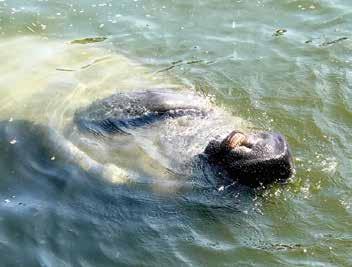prOTECTINg ThE CrOATAN

A NATurAL muSEum TO ENjOy
By Janice Allen Coastal Land Trust Land Protection Director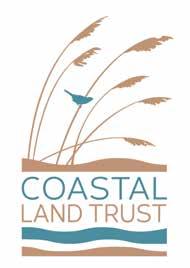
“That’s the old Swansboro Highway,” said Mr. Curtis Dixon, as he pointed to a narrow sandy path that led into the Croatan National Forest from the edge of his Carteret County property. I stared at the “highway” and wondered how long ago it was last used. Mr. Dixon was not sure, but he believed it was once a wagon road from this area of Newport to Swansboro.
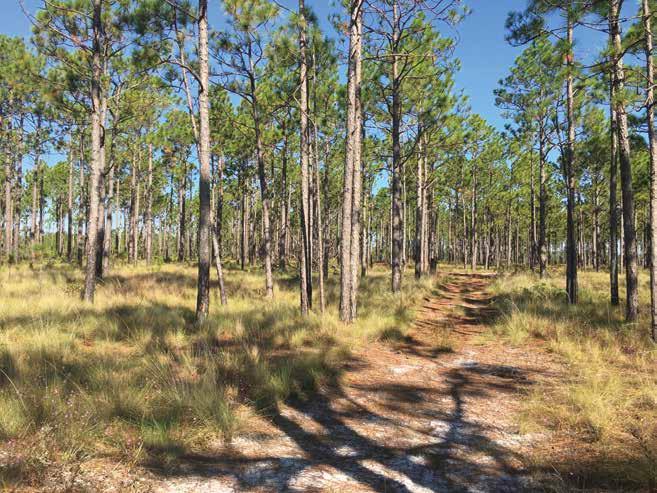
As Mr. Dixon and I walked the path into the forest, I wondered if the old-time travelers ever felt a sense of awe, like I was feeling, as they moved through this amazingly stunning longleaf forest. Perhaps not. Like travelers today, they were likely focused on getting to their destination, and prior to the mid-to-late
ThE prOmISE Of SprINg
 By Camilla Herlevich Coastal Land Trust Founder and Executive Director
By Camilla Herlevich Coastal Land Trust Founder and Executive Director
In late March, as I sat and looked outside my window here at home, though the streets were empty, the azaleas and dogwoods and daffodils still moved gently in the breeze. “Look around you,” Nature seemed to be telling me. “Listen to the song of the birds. Sit among the dogwoods. There is more to come as the days unfold.”
These are unprecedented times to be sure; so nature’s messages may not always get heard. My colleagues and I at the Coastal Land Trust, like all of you, are making changes every day— sometimes, it seems, every hour!
Like most other businesses and nonprofits, we are working from home. We are learning from our volunteer leaders, and from others in the nonprofit community, how to keep our
organization thriving, and our employees safe, healthy, supported, and productive.
We had to cancel our Spring events and we’ve missed seeing you in person! But since we can’t meet you out on the land right now, we are working to bring the beauty and restorative powers to you—virtually! For example, “Flytrap Frolic Livestream!” which aired on social media on April 30, has now been viewed more than 3,800 times. Watch it here: CoastalLandTrust.org/carnivorous.
We know that for you, like us, nature matters. Nature’s rhythms comfort us, and nature’s beauty renews our spirit. Spring, especially, is nature’s time of renewal and hope. As surely as waves break along the beach, summer will follow spring, and the challenges that are so overwhelming today will eventually pass.
Our goal at the Coastal Land Trust is to “keep calm and carry on.” First
NEw STAff
Sandy Marshall Business Director
Sandra (Sandy) Nicole Marshall joined the Coastal Land Trust as our new full-time Business Director on March 28th.
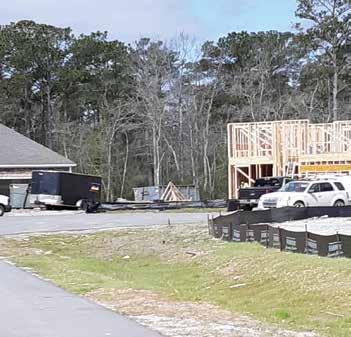




Sandy has over 13 years of experience in accounting, financial management & reporting, budgeting, grants management, and human resources. She most recently held the position of Director of Finance & Administration at the Jewish Federation of Durham-Chapel Hill (a non-profit with a $4 million annual budget).
Sandy has a bachelor of science degree in Business Administration from Salem College and a master of business administration from Queens university of Charlotte.
In her spare time Sandy enjoys the outdoors, cooking, jigsaw puzzles, watching all sports (especially uNC basketball) and spending time with her nieces, Ava and Sydney.
TrIvIA
19th Century, the longleaf forest was vast, seemingly endless. However, this path may have traversed a very different landscape after the logging boom of the late 19th to early 20th centuries. In fact, in July 1936, President Franklin D. roosevelt designated 77,000 acres of North Carolina’s mid-coast as the Croatan National Forest, originally to be used for reforestation experiments.
Today, at 160,000 acres, the Croatan National Forest represents one of our country’s natural treasures. It is still used for forestry and enjoyed for recreation, but it also hosts a natural museum of plant and animal life. From its longleaf pine forests, cypress-gum swamps, bottomland hardwoods, maritime forest, limesink ponds, estuarine marsh, and pocosin wetlands, the Croatan provides home for wildlife species such as black bear, wild turkey, and American alligator. It also provides refuge for numerous rare and/ or unusual plant and animal species such as Venus flytraps, purple pitcher plants, Carolina gopher frogs, red-cockaded woodpeckers, Northern long-eared bats, and fox squirrels.
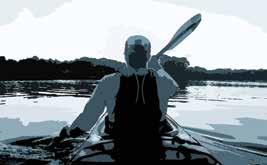
Make no mistake, the Croatan is impressive, and it is Our LAND to enjoy, and protect. As our coastal human population increases, more homes and businesses are built adjacent to the forest, creating more wildland-urban interface. This not only puts a squeeze on local wildlife moving from one place to another, but it also makes it difficult for the u.S. Forest Service to conduct much-needed prescribed burning on the forest due to smoke and escaped fire concerns.
In April 2018, the Coastal Land Trust received $7.3 million from a settlement between N.C. Department of Transportation and Sierra Club over the State’s proposed u.S. 70 Bypass around Havelock that would cut through a portion of the Croatan
National Forest and directly impacts 264 acres and isolates or fragments another 1,000+ acres. The Sierra Club directed the Coastal Land Trust to use those funds to purchase and conserve lands in and around the Croatan in Jones, Craven, and/ or Carteret counties. The Coastal Land Trust was honored, and admittedly thrilled, to take on this important assignment (that we call the Croatan Protection Initiative) because buffering and connecting existing conservation lands on our coast is exactly what we do best.
We rolled up our sleeves, went to work, and, in just two years, the Coastal Land Trust acquired 5 outstanding properties totaling 1,460 acres adjacent to the Croatan.
Specifically, we conserved 113 acres of longleaf forest along Gales Creek adjacent to our Gales Creek Preserve in Carteret County.
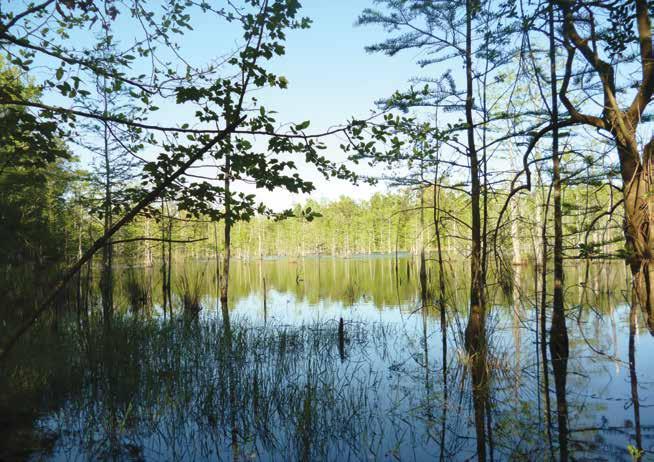
In Craven County, we acquired 182 acres of upland pine and forested wetlands in the Black Creek headwaters; 350 acres of thinned loblolly pine forest adjacent to numerous red-cockaded woodpecker nest sites off County Line road, and 568 acres of scenic pinehardwoods dotted with manmade and natural ponds off Perrytown Loop road.
The most exciting was the purchase of 247 acres along 2.4 miles of Island Creek in Jones County which not only protects the viewshed for the u.S. Forest Service’s Island Creek Forest Walk Trail but also conserves a very biologically rich and rare forest community with towering hardwoods and outcroppings of marl.
Finally, because the Coastal Land Trust strategically leveraged or matched the settlement dollars whenever possible with other federal, state, and private grant funds, there are more dollars left to spend to protect lands in and around the Croatan.
Cassie Gavin, Senior Director of Government Affairs for the North Carolina Chapter of the Sierra Club, gave the Coastal Land Trust a thumbs up for our accomplishments to date with the Croatan Protection Initiative. “N.C. Sierra Club members from the mountains to the sea, especially those in the Croatan Group, are pleased to see so many unique properties conserved around the Croatan in such a short time. It’s critical to protect rare habitats like longleaf pine forests and the animals that live there. We’re excited to see the conservation efforts continue!” she said.
In today’s time of unprecedented uncertainty, one thing IS certain, the Coastal Land Trust is continuing to save special places here at the coast.























































COASTAL TrEE TrEASurES CAmpAIgN A I m E d AT rESTO r IN g L OST fO r ESTS
The Coastal Land Trust’s Coastal Tree Treasures campaign is a concerted effort to restore longleaf pine and Atlantic white cedar forests where appropriate on our nature preserves. The federal government considers both longleaf pine and Atlantic white cedar forests to be imperiled ecosystems.

Longleaf pine forests once blanketed the Southeast covering an estimated 90 million acres from southern Virginia down along the Atlantic Coast to Florida and along the Gulf Coast to east Texas. Only 3% to 4% of longleaf pine’s historical population is left.
Atlantic white cedar forests once occurred in swamps, bogs and along waterways on the Atlantic Coast from southern Maine to Georgia, and along the Gulf Coast from northern Florida to Mississippi. Now only 5% of its historic coverage remains. The North Carolina Forest Service estimated North Carolina once had more than 200,000 acres of Atlantic white cedar back in the 1800s at places like the Great Dismal Swamp, Albemarle-Pamlico Peninsula, and along the Waccamaw river. Now, only 10,000 acres remain.
Heavy logging in the 1800s and early 1900s took its toll on these forests, while habitat loss or alteration for a myriad of human uses continues today. The unique ecology of longleaf pine and Atlantic white cedar also poses challenges for natural regeneration of these tree species.
With funding from the u.S. Fish and Wildlife Service, International Paper Foundation, and an anonymous donor, the Coastal Land Trust launched a multi-pronged campaign to help protect and restore these once glorious forests. Aside from acquiring sites with existing longleaf pine or Atlantic white cedar, the Coastal Land Trust is restoring and/or enhancing sites through tree planting, timber stand improvements, and/or prescribed burning.
To date, more than 180 acres of longleaf pine have been planted on the Gales Creek, Magnolia, Everett Creek, and Dupont preserves with an additional five acres planted in 2019.
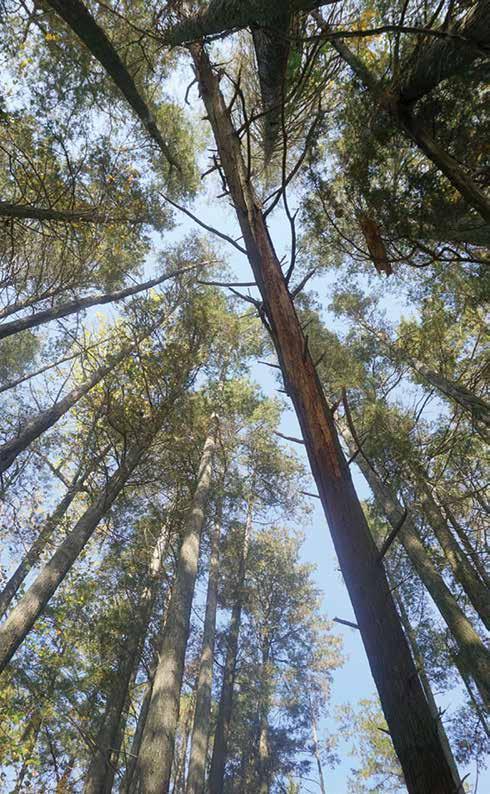
Atlantic white cedar was planted on five acres of the Waccamaw Preserve in 2019 with an additional 50+acres to be planted this fall. Prescribed burning in longleaf pine forests, which helps control mid-story hardwood growth and promotes spread of native grasses and wildflowers, has been ramped up. In 2019, controlled burns were completed on 273 acres of existing longleaf pine forest at Gales Creek, Magnolia, Everett Creek, Dupont and B.W. Wells Savannah Preserves.
The Coastal Land Trust has also been educating future generations about the natural history and conservation significance of longleaf
pine forests. In 2019, our AmeriCorps Service Member, Lillie reiter, visited 12 classrooms and/or
curricula.
Through on-the-ground restoration work and hands-on educational efforts directed at youth, the Coastal Land Trust is contributing to the recovery and appreciation of these coastal tree treasures in North Carolina.
We’ve witnessed the destruction of wildlife habitat in our community in coastal North Carolina, mostly due to land clearing for new homes. The staggering decline in bird and other wildlife populations in just our neighborhood has been disturbing. We believe habitat loss is the most serious threat to wildlife in our country and abroad. By naming Coastal Land Trust as the beneficiary of our estate, we hope to help mitigate some of the damage.
ChECk prESENTATION
Al Beatty, President of the Cedar Hill West Bank Foundation is presenting a $10,000 check for the restoration of reaves Chapel to Jesica Blake, Assistant Director of the Coastal Land Trust. Cedar Hill West Bank had a successful gospel brunch fundraiser at Navassa Town Center that enabled them to give this money to the reaves Chapel project.

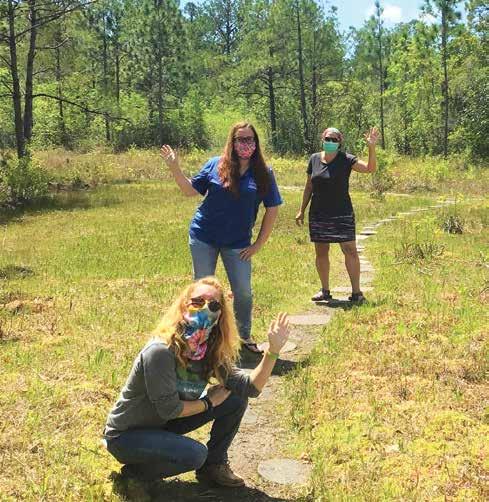
The Coastal Land Trust and Cedar Hill West Bank are continuing to fundraise to save historic reaves Chapel. Be a part of saving history. Donate at: CoastalLandTrust.org/donate/ and designate reaves Chapel restoration Fund.
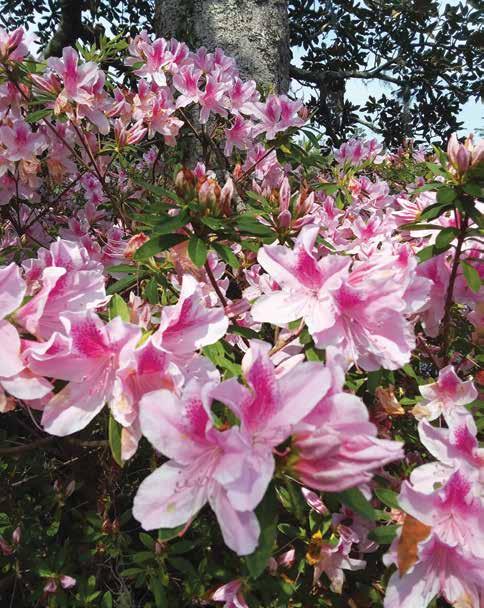
SAvE
SPrIng Continued from page 1
and foremost, that means that we are continuing our mission of saving coastal lands and special places.
November 8, 2020
SCrApBOOk
Coastal Land Trust Volunteer Trail Days spruce up area preserves
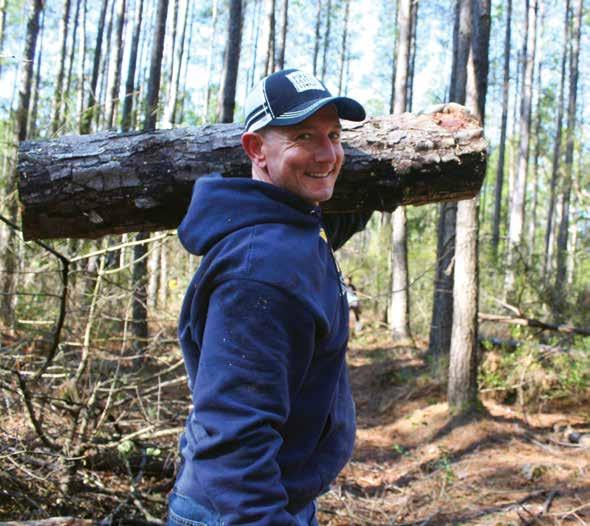
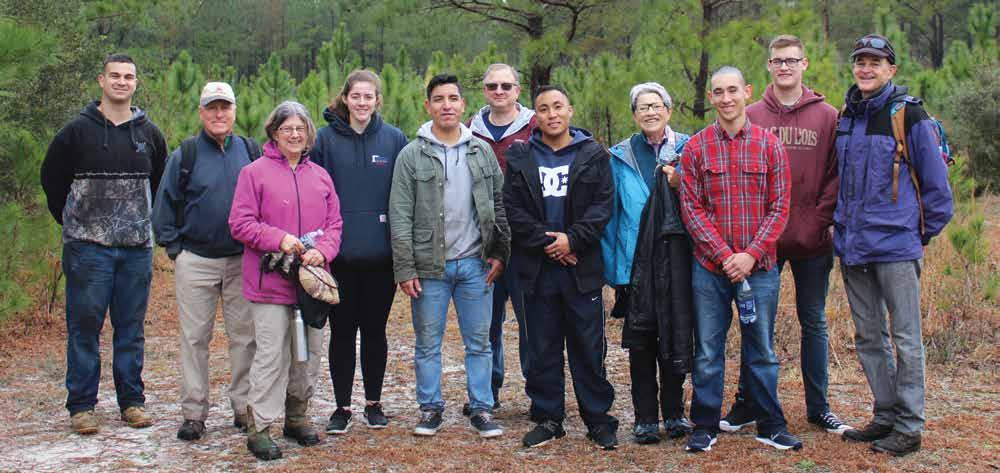
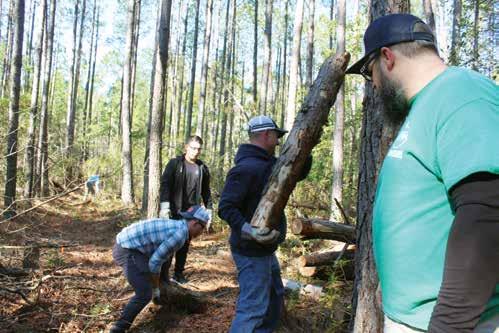
1, 2020
POLLINATOr GArDEN PEOPLE
Volunteer Trail Day
Brunswick Nature Park | March 7, 2020
NEW Tr AIL HEAD AT BruNSWICk NATurE PArk
Volunteers from the Coastal Land Trust teamed up with Dave Ellegood from Cape Fear SOrBA (Southern Off-road Bicycle Association) to create a new trail head near the gazebo at The Brunswick Nature Park. A total of 15 volunteers worked together to accomplish the project in just two hours.
NATurE TrIvIA ANSwEr
from page 2
Answer: B. Believe it or not in 2010, North Carolina had the highest area wildland-urban interface in the country at 54,956 square kms; California had 27,026 square kms. This data comes from a study entitled, rapid Growth of the u.S. wildland/urban interface raises wildfire risk, published in the Proceedings of the National Academy of Sciences in 2018.
See www.nrs.fs.fed.us/data/wui/state_summary/.
p hoto by Tom Earnhardt wIL d pONIES AT Sh AC k LE f O rd B AN k S | C A p E LOO k O u T , C A r TE r ET CO u NT y

CoastalLandTrust.org/donate
is continuing to save special places.
IS certain, your Coastal Land Trust
In today’s time of uncertainty, one thing
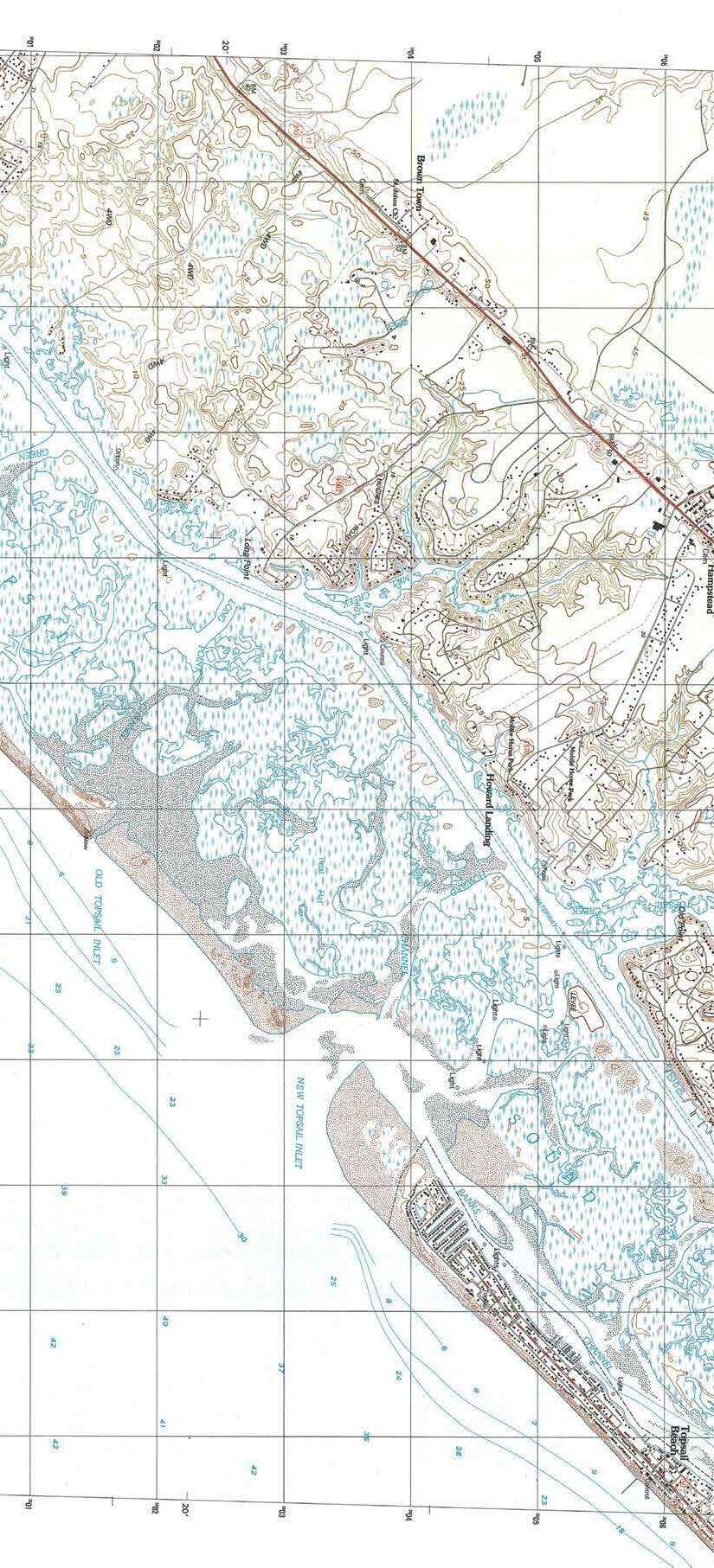
Wilmington, North Carolina 28412 VOLUME 20 // ISSUE 2 // Summer 2020
U.S. Postage PAID Permit No. 316 Wilmington, NC
dISpATChES frOm ThE wILd SIdE
On the Black river and other coastal rivers, April is the time to be serenaded by warblers, watched by baby barred owls.
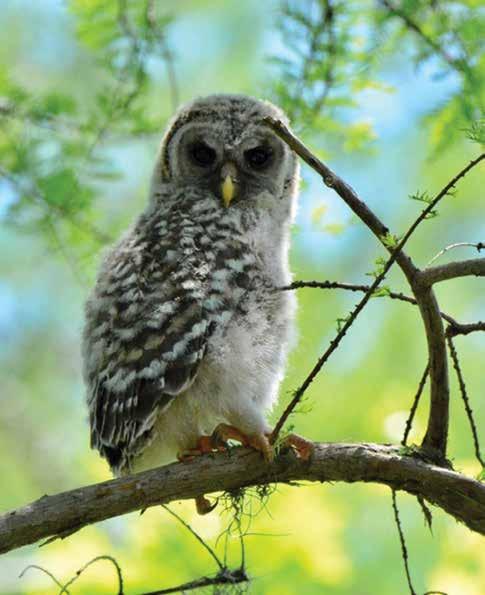
3 Pine Valley Drive COAST LINES www.CoastalLandTrust.org PAGE 8
T
om Earnhardt, awardwinning nature writer, photographer and producer, emailed us during the third week of March, promising to send pictures each week, while we were all “hunkered down,” to remind us that the world around us is still beautiful, ever changing, and very much alive. As co-producer of public TV’s “Exploring North Carolina,” Tom has visited every corner of the state.
showcase our state’s rich natural heritage, from Bald Head Island to Cape Lookout, Southport to Currituck, umstead Park to Pilot Mountain, and from Linville Gorge and Panthertown Valley to the high peaks of Mitchell, Grandfather and roan.
Good as his word, Tom has sent us gorgeous photos every week since then—photos thatIt has been our pleasure to share them with you via our email list, and on our website (CoastalLandTrust.org). We’re so grateful for this reminder that as we get through the coming days together, a beautiful world will be waiting for us. Thank you, Tom!
From early May through summer, whether you are in a powerboat, paddling a kayak, or wading, look for unexpected wakes or shapes. you may see an ocean-going turtle or friendly manatee. This 10 to 12 foot manatee called the waters near Swansboro home last summer.
